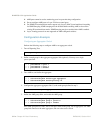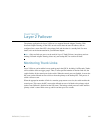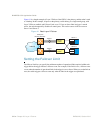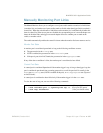
BLADEOS 6.5.2 Application Guide
328 Chapter 23: Layer 2 Failover BMD00220, October 2010
L2 Failover with Other Features
L2 Failover works together with Link Aggregation Control Protocol (LACP) and with Spanning
Tree Protocol (STP), as described below.
LACP
Link Aggregation Control Protocol allows the switch to form dynamic trunks. You can use the
admin key to add up to two LACP trunks to a failover trigger using automatic monitoring. When
you add an admin key to a trigger, any LACP trunk with that admin key becomes a member of the
trigger.
Spanning Tree Protocol
If Spanning Tree Protocol (STP) is enabled on the ports in a failover trigger, the switch monitors the
port STP state rather than the link state. A port failure results when STP is not in a Forwarding state
(such as Listening, Learning, Blocking, or No Link). The switch automatically disables the
appropriate control ports.
When the switch determines that ports in the trigger are in STP Forwarding state, then it
automatically enables the appropriate control ports. The switch fails back to normal operation.
Configuration Guidelines
This section provides important information about configuring Layer 2 Failover.
Any specific failover trigger can monitor ports only, static trunks only, or LACP trunks only.
The different types cannot be combined in the same trigger.
A maximum of 24 LACP keys can be added per trigger.
Port membership for different triggers should not overlap. Any specific port should be a
member of only one trigger.


















